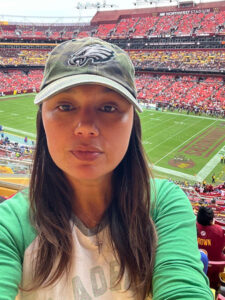When Passion Becomes Purpose By Teresa Moore
I’ve always known I wanted to be a teacher. For as long as I can remember, school felt like a magical place, a world where anything was possible. Growing up, school was more than just a building with desks and chalkboards; to me, it was an escape. It was a space where curiosity was encouraged, where I could discover something new each day, and where I felt surrounded by friends who shared in the joy of learning. I loved the structure of the day, moving from one subject to the next, each one bringing a different challenge. I loved the excitement of physical education, the freedom of recess, and the calm joy of library time. All of those moments were stitched together into something that felt safe and fulfilling. Most of all, school was a place where I could simply be a kid.
It was this sense of wonder and belonging that planted the seed for my future career. I knew early on that I wanted to recreate that experience for other children. My dream was to create a classroom environment where students could feel the same joy I felt—a place where they could love learning, where they felt free to be themselves, and where they could simply enjoy the experience of being children. To me, teaching has never been just about academics. It has always been about fostering a safe, nurturing, and inspiring space that allows children to grow in every sense of the word.
When I entered graduate school to pursue my Master’s in Education, I was faced with an important decision: what grade level would I teach? At first, I struggled with the choice. Each level—elementary, middle, and high school—offered its own unique challenges and rewards. Elementary school appealed to me because of the foundational skills students develop at that age, skills that shape their future success. Middle school called to me because of the energy, growth, and curiosity that come with adolescence. High school intrigued me because of the independence of older students and the opportunities to help them prepare for the real world. Choosing just one felt impossible.
I wrestled with the decision until my student advisor made a suggestion that changed everything: Special Education. She explained that this path would allow me to teach across all grade levels and, even more importantly, to work with students who often struggled in general education classrooms. These were students who needed extra support, individualized instruction, and someone to advocate for them. The moment I heard this, it clicked. Special Education was not just a compromise between grade levels; it was a calling. It would give me the chance to meet students where they were, to celebrate their unique strengths, and to help them overcome obstacles that others might not even notice. It was, for me, a no-brainer.
Since then, I have come to deeply appreciate the many hats teachers wear every single day. We are not only instructors but also planners, assessors, mentors, coaches, cheerleaders, counselors, mediators, advocates, role models, and so much more. As a collaborative special education teacher and case manager, I wear all of these hats and then some. My work requires me to constantly shift roles depending on the needs of my students, their families, and my colleagues.
In my role as a collaborative teacher, I work side by side with general education teachers. Together, we co-teach lessons, ensuring that students with special needs can access the curriculum meaningfully. I monitor individual goals, check that accommodations are being followed, and make modifications when necessary. I also assist in managing classroom behavior, creating an environment where every student can thrive. Collaboration is at the heart of this work—it requires flexibility, communication, and a shared commitment to student success.
As a case manager, my responsibilities expand even further. I collect data and input from a team that includes parents, general education teachers, specialists, and administrators. I use this information to write Individualized Education Plans (IEPs), which outline the goals, services, and supports each student needs to succeed. I lead annual meetings to review student progress, adjust goals, and ensure that we are providing the right services at the right time. Beyond the paperwork and meetings, I check in regularly with my students, maintain open lines of communication with parents, and partner with teachers to support classroom learning.
At the heart of all of this is my passion for connecting with students. I genuinely enjoy being in the classroom, finding ways to engage students in learning, and making it fun and meaningful for them. I strive to create a classroom environment where students feel safe to take risks, ask for help, and be themselves. I often tell people that I see myself as an educator not just for academics, but for the whole well-being of my students. Academic success is important, but so is building confidence, resilience, and self-advocacy.
My classroom reflects this philosophy. It is decorated to be warm and inviting, a space that feels less like a sterile institution and more like a community where students belong. I believe that environment matters—students should walk into the room and feel safe, comfortable, and ready to learn. Just as important as the physical environment is the relational one. I make it a priority to build strong, healthy relationships with each of my students. I learn about their interests, celebrate their achievements, and support them through their struggles.
I believe that relationships are the key to academic success. When students know that I care about them as individuals, they are more willing to ask for help, to admit when they don’t understand something, and to embrace mistakes as opportunities to learn. They develop a sense of trust and belonging that motivates them to work harder and push themselves further.
Teaching, to me, is both a privilege and a responsibility. It is the privilege of walking alongside students as they grow, guiding them as they discover who they are and what they are capable of. It is the responsibility of creating a space where every student feels seen, valued, and supported. Every day, I am reminded of why I chose this path: because school once gave me a place to belong, and now it is my mission to give that gift back to others. ❦
 About the Author
About the Author
Teresa Moore is a Special Education teacher in Northern Virginia with almost two decades of working with and nurturing young children.
A devoted educator, she thrives on creating a welcoming environment for her students and providing opportunities for them to succeed.
As a military spouse and mother, she enjoys spending time with her family, exploring nature, walking her dog, and cheering on her favorite NFL team.
